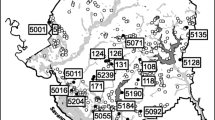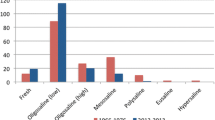Abstract
We conducted a field study to examine the influence of hydroperiod and concomitant changes in abiotic (wetland size, pH, conductivity, dissolved oxygen and water temperature) and biotic (predatory fish presence) characteristics on macroinvertebrate communities in isolated wetlands in southern New Hampshire. Invertebrates were sampled using dipnet sweeps in 42 wetlands with short (<4 months), intermediate (4–11 months) or long (permanent) hydroperiods in 1998 and 1999. We found that invertebrate genera richness, and to a lesser degree abundance, increased linearly along the hydrological gradient, and in response to temperature and dissolved oxygen. Relative abundance of genera also differed markedly with respect to hydroperiod. Most notably, invertebrate communities changed from Acilius-dominated communities to Notonecta-dominated communities. Invertebrate relative abundances in permanent wetlands also differed with respect to the occurrence of predatory fish. Some genera (e.g., Libellula, and Dytiscus) were more likely to occur in permanent wetlands without fish, whereas other genera (e.g., Buena, and Basiaeshna) were more likely to occur in wetlands with predatory fish. Because aquatic invertebrate communities differed markedly with respect to wetland hydroperiod, and in relation to the occurrence of predatory fish, it is essential to retain a diversity of wetlands in the landscape to ensure the long-term persistence of aquatic invertebrate biodiversity.
Similar content being viewed by others
References
K.J. Babbitt M.J Baber T.L. Tarr (2003) ArticleTitlePatterns of larval amphibian distribution along the wetland hydroperiod gradient Can. J. Zool. 81 1539–1552 Occurrence Handle10.1139/z03-131
D.P. Batzer C.R. Jackson M. Mosner (2000) ArticleTitleInfluences of riparian logging on plants and invertebrates in small, depressional wetlands of GeorgiaUSA Hydrobiologia 44 123–132 Occurrence Handle10.1023/A:1017558523802
J.R. Bray J.T. Curtis (1957) ArticleTitleAn ordination of the upland forest assemblages of southern Wisconsin Ecol. Monogr. 27 325–349
R.T. Brooks (2000) ArticleTitleAnnual and seasonal variation and the effects of hydroperiod on benthic macroinvertebrates of seasonal forest (“vernal”) ponds in central Massachusetts, USA Wetlands 20 707–715
J.P. Caldwell J.H. Thorp T.O. Jervey (1980) ArticleTitlePredator–prey relationships among larval dragonflies, salamanders and frogs Oecologia 46 285–289
K.R. Clarke (1993) ArticleTitleNon-parametric multivariate analyses of changes in community structure Aust. J. Ecol. 18 117–143
E.A. Colburn (1995) Certified: A Citizen’s Step-by-step Guide to Certifying Vernal Pools. 6th ed Massachussetts Audubon Society Lincoln, MAUSA
D. Collet (1994) Modeling Binary Data Chapman and Hall London
D. Corti S.L. Kohler R.E. Sparks (1999) ArticleTitleEffects of hydroperiod and predation on a Mississippi River floodplain invertebrate community Oecologia 109 154–165 Occurrence Handle10.1007/s004420050070
D.F. Donahue (1995) A Guide to the Identification and Protection of Vernal Pool Wetlands of Connecticut University of Connecticut Cooperative Extinction and Connecticut Forest Stewardship Program Storrs, CT, USA
W.G. Duffy (1999) Wetlands of Grand Teton and Yellowstone National Parks: aquatic invertebrate diversity and community structure D.P. Batzer R.B. Rader S.A. Wissinger (Eds) Invertebrates in Freshwater Wetlands of North America John Wiley and Sons New York, NY, USA 733–756
C.H. Eriksen V.H. Resh G.A. Lamberti (1996) Aquatic insect respiration R.W. Merritt K.W. Cummins (Eds) An Introduction to the Aquatic Insects of North America. 3rd ed Kendall–Hunt Publishing DubuqueIAUSA 29–40
InstitutionalAuthorNameESRI Inc. (1999) ArcInfo User’s Manual Version 7.2.1 Environmental Systems Research Institute Inc Redlands, CAUSA
J.P. Gibbs (1993) ArticleTitleImportance of small wetlands for the persistence of local populations of wetland-associated animals Wetlands 13 25–31
N. Giles R.M. Wright E.A. Shoesmith (1995) ArticleTitleThe effects of perchPerca fluviatilisbronze breamAbramis bramaon insect emergence and benthic invertebrate abundance in experimental ponds Fish. Manage. Ecol. 2 17–25
I. Hanski M.E. Gilpin (1991) ArticleTitleMetapopulation dynamics: a brief history and conceptual domain Biol. J. Linn. Soc. 42 3–16
M.A. Hanson M.R. Riggs (1995) ArticleTitlePotential effects of fish predation on wetland invertebrates: a comparison of wetlands with and without fathead minnows Wetlands 15 167–175
K.L. Heck SuffixJr. L.B. Crowder (1991) Habitat structure and predator–prey interactions in vegetated aquatic systems S.S. Bell E.D. McCoy H.R. Mushinsky (Eds) Habitat Structure Chapman and Hall New York, NY, USA 281–299
A.E. Hershey L. Shannon G.J. Niemi A.R. Lima R.R. Regal (1999) Prairie wetlands of south-central Minnesota: effects of drought on invertebrate communities D.P. Batzer R.B. Rader S.A. Wissinger (Eds) Invertebrates in Freshwater Wetlands of North America John Wiley and Sons New York, NY, USA 515–542
J.D. Huener J.A. Kadlec (1992) ArticleTitleMacroinvertebrates response to marsh management strategies in Utah Wetlands 12 72–78
S.K. Kholin A.N. Nilsson (1998) ArticleTitleRegional enrichment of predacious water beetles in temporary ponds at opposite east-west ends of the Palearctic J. Biogeogr. 25 47–55 Occurrence Handle10.1046/j.1365-2699.1998.251160.x
S.L. Kohler D. Corti M.C. Slamecka D.W. Schneider (1999) Prairie floodplain ponds: mechanisms affecting invertebrate community structure D.P. Batzer R.B. Rader S.A. Wissinger (Eds) Invertebrates in Freshwater Wetlands of North America John Wiley and Sons New York, NY, USA 711–730
D.A. Leeper B.E. Taylor (1998) ArticleTitleAbundancebiomass, and production of aquatic invertebrates in Rainbow Bay, a temporary wetland in South CarolinaUSA Archives fur Hydrobiologia 143 335–362
M.L. Mallory P.J. Blancher P.J. Weatherhead D.K. McNicol (1994) ArticleTitlePresence or absence of fish as a cue to macroinvertebrate abundance in boreal wetlands Hydrobiologia 279–280 345–351 Occurrence Handle10.1007/BF00027866
S. McCormick G.A. Polis (1982) ArticleTitleArthropods that prey on vertebrates Biol. Rev. 57 29–58 Occurrence Handle10.1086/412574
P. McCullagh J.A. Nelder (1989) Generalized Linear Models. 2nd ed Chapman and Hall London, UK
B. McCune M.J. Mefford (1997) PC-ORD. Multivariate Analysis of Ecological DataVersion 3.0 MjM Software Design Gleneden BeachOR, USA
R.W. Merritt K.W. Cummins (1996) An Introduction to the Aquatic Invertebrates of North America. 3rd ed Kendall/Hunt Publishing Company DubuqueIAUSA
R.W. Merritt K.W. Cummins M.B. Berg J.A. Novak M.J. Higgins K.J. Wessell J.L. Lessard (2002) ArticleTitleDevelopment and␣application of a macroinvertebrate functional-group approach in the bioassessment of remnant river oxbows in southwest Florida J. N Am. Benthol. Soc. 21 290–310
P.R. Minchin (1987) ArticleTitleAn evaluation of the relative robustness of techniques in ordination Vegetatio 69 89–107 Occurrence Handle10.1007/BF00038690
W.J. Mitsch J.G. Gosselink (1993) Wetlands. 2nd ed Van Nostrand Reinhold NY, USA
P.J. Morin S.P. Lawler D.E. Johnson (1988) ArticleTitleCompetition between aquatic insects and invertebrates: interaction strength and higher order interactions Ecology 69 1401–1409
A.N. Nilsson B.W. Svensson (1995) ArticleTitleAssemblages of dytiscid predators and culicid prey in relation to environmental factors in natural and clear-cut boreal swamp forest pools Hydrobiologia 308 183–196
P.W.C. Paton W.B. Crouch SuffixIII. (2002) ArticleTitleUsing the phenology of pond-breeding amphibians to develop conservation strategies Conserv. Biol. 16 194–204 Occurrence Handle10.1046/j.1523-1739.2002.00260.x
J.H.K. Pechmann R.A. Estes D.E. Scott J.W. Gibbons (2001) ArticleTitleAmphibian colonization and use of ponds created for trial mitigation of wetland losses Wetlands 21 93–111
B.L. Peckarsky P.R. Fraissinet M.A. Penton D.J. Conklin SuffixJr. (1990) Freshwater Macroinvertebrates of Northeastern North America Cornell University Press IthacaNY, USA
C.L. Pierce B.D. Hinrichs (1997) ArticleTitleResponse of littoral invertebrates to reduction of fish density: simultaneous experiments in ponds with different fish assemblages Freshwater Biol. 37 397–408 Occurrence Handle10.1046/j.1365-2427.1997.00169.x
A.H. Roth J.F. Jackson (1987) ArticleTitleThe effect of pool size on recruitment of predatory insects and on mortality in a larval anuran Herpetologica 43 224–232
InstitutionalAuthorNameSAS. (2001) SAS/STAT software Version 8m SAS institute Cary, NC, USA
D.W. Schneider T.M. Frost (1996) ArticleTitleHabitat duration and community structure in temporary ponds J. N Am. Benthol. Soc. 15 64–86
R.D. Semlitsch J.R. Bodie (1998) ArticleTitleAre small, isolated wetlands expendable? Conserv. Biol. 12 1129–1133 Occurrence Handle10.1046/j.1523-1739.1998.98166.x
P. Shriver J. Bogestrand E. Jeppesen M. Sondergaard (1995) ArticleTitleImpact of submerged macrophytes on fish–zooplankton–phytoplankton–interactions: large-scale enclosure experiments in a shallow eutrophic lake Freshwater Biol. 33 255–270
D.K. Skelly L.K. Freidenburg J.M. Kiesecker (2002) ArticleTitleForest canopy and the performance of larval amphibians Ecology 83 983–992
D.K. Skelly E.E. Werner S.A. Cortwright (1999) ArticleTitleLong-term distributional dynamics of a Michigan amphibian assemblage Ecology 80 2326–2337
J.W. Snodgrass M.J. Komoroski A.L. Bryan SuffixJr. J. Burger (2000a) ArticleTitleRelationships among isolated wetland sizehydroperiodand amphibian species richness: implications for wetland regulations Conserv. Biol. 14 414–419 Occurrence Handle10.1046/j.1523-1739.2000.99161.x
J.W. Snodgrass A.L. Bryan SuffixJr. J. Burger (2000b) ArticleTitleDevelopments of expectations of larval amphibian assemblage structure in southern depression wetlands Ecol. Appl. 10 1219–1229
M. Spencer L. Blaustein S.S. Schwartz J.E. Cohen (1999) ArticleTitleSpecies richness and the proportion of predatory animal species in temporary freshwater pools: relationships with habitat size and permanence Ecol. Lett. 2 157–166 Occurrence Handle10.1046/j.1461-0248.1999.00062.x
M.K. Stone J.B. Wallace (1998) ArticleTitleLong-term recovery of a mountain stream from clear-cut logging: the effects of forest succession on benthic invertebrate community structure Freshwater Biol. 39 151–169 Occurrence Handle10.1046/j.1365-2427.1998.00272.x
A. Tappan (1997) Identification and Documentation of Vernal Pools in New Hampshire New Hampshire Fish and Game DepartmentNongame and Endangered Wildlife Program ConcordNH, USA
E.M. Walker (1958) The Odonata of Canada and AlaskaVol. 2 Oxford University Press London, UK
G.A. Wellborn D.K. Skelly E.E. Werner (1996) ArticleTitleMechanisms creating structure across a freshwater habitat gradient Ann. Rev. Ecology Syst. 27 337–363 Occurrence Handle10.1146/annurev.ecolsys.27.1.337
E.E. Werner K.S. Glennemeier (1999) ArticleTitleInfluence of forest canopy cover on breeding pond use of several amphibian species Copeia 1999 1–12
E.E. Werner M.A. McPeek (1994) ArticleTitleDirect and indirect effects of predators on two anuran species along an environmental gradient Ecology 75 1368–1382
G.B. Wiggens R.J. MacKay I.M. Smith (1980) ArticleTitleEvolutionary and ecological strategies of animals in annual temporary pools Archives fur Hydrobiologia Supplement 58 97–206
D.D. Williams (1996) ArticleTitleEnvironmental constraints in temporary fresh waters and their consequences for the insect fauna J. N Am. Benthol. Soc. 14 634–650
S.A. Wissinger A.J. Boonak H.H. Whiteman W.S. Brown (1999) Subalpine wetlands in Colorado: habitat permanencesalamander predation, and invertebrate communities D.P. Batzer R.B. Rader S.A. Wissinger (Eds) Invertebrates in Freshwater Wetlands of North America John Wiley and Sons New York, NY, USA 757–790
S.A. Wissinger L.J. Gallagher (1999) Beaver pond wetlands in northwestern Pennsylvania: modes of colonization and succession after drought D.P. Batzer R.B. Rader S.A. Wissinger (Eds) Invertebrates in Freshwater Wetlands of North America John Wiley and Sons New York, NY, USA 333–362
Author information
Authors and Affiliations
Corresponding author
Rights and permissions
About this article
Cite this article
Tarr, T.L., Baber, M.J. & Babbitt, K.J. Macroinvertebrate community structure across a wetland hydroperiod gradient in southern New Hampshire, USA. Wetlands Ecol Manage 13, 321–334 (2005). https://doi.org/10.1007/s11273-004-7525-6
Received:
Accepted:
Issue Date:
DOI: https://doi.org/10.1007/s11273-004-7525-6




